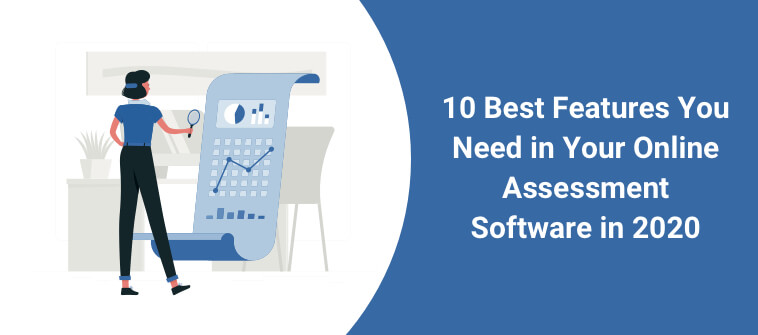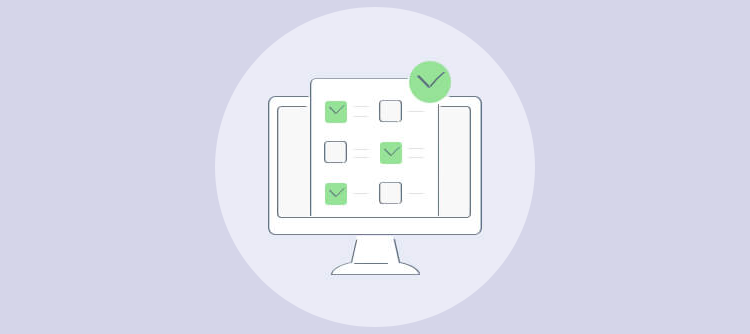Think back to the lessons that truly stuck with you. Chances are, it wasn’t the final grade that made them memorable—it was the feedback, the reflection, the process.
Formative assessment has always been a core part of how we train and develop teams at ProProfs. Not because it sounds good on paper but because it gives us a real edge—spotting what’s working, what’s not, and where we’re losing people before it costs us time or results.
In this guide, I’ll break down what formative assessment looks like in practice, share some examples, and offer actionable strategies you can start using right away—whether you’re running a classroom or a team.
Let’s get into it.
What Is a Formative Assessment?
Definition: Formative assessment is an ongoing process educators and trainers use to check how well learners are grasping new concepts—while the learning is still happening. Think of it as an assessment for learning, not assessment of learning. It’s meant to guide improvement in real time, not just tally up scores.
Whether you’re in a classroom or a corporate training session, formative assessments help identify gaps early so instructors can tweak their approach—and learners can course-correct without the pressure of grades or final judgments.
These assessments might look like short quizzes, open-ended group discussions, peer feedback, or even quick self-checks. What matters most is that they give timely insights both learners and instructors can act on immediately.
In workplace training, formative assessments play a key role in keeping employees engaged and on track. For example, a mid-course knowledge check or a team brainstorming session can help managers understand who’s ready to move forward and who needs a bit more support.
Watch: How to Create an Online Quiz in Under 5 Mins
What Is the Purpose of Formative Assessment?
At its core, the purpose of formative assessment is to make learning flexible, responsive, and way more effective. It’s not just about checking knowledge—it’s about shaping it.
In real-world terms, that means spotting the “wait, I didn’t get that” moments before they snowball into confusion. Formative assessment helps you adjust as you go—no need to wait for a test or a quarterly review to find out something missed the mark.
Here’s what it unlocks when used well:
- Real-time course correction: You can adapt your teaching or training based on what learners actually need in the moment.
- Personalized learning paths: Everyone learns differently, and formative assessments help you catch those differences and respond to them.
Continuous engagement: Learners aren’t just absorbing information—they’re interacting with it, reflecting on it, and applying it.
Formative vs. Summative Assessment: What’s the Difference?
Here’s where things often get mixed up—formative assessment isn’t just a smaller version of a test. It serves a completely different purpose than a summative assessment, and understanding the contrast can help educators and workplace trainers make smarter decisions.
Think of formative assessment as your GPS. It tells you in real time when to reroute, slow down, or take a different approach—while learning is still in motion. Summative assessment, on the other hand, is more like a final report. It tells you where you ended up but doesn’t help much while you’re on the journey.
Whether you’re teaching a classroom full of students or onboarding new employees, knowing when to use each can make all the difference in outcomes.
| Feature | Formative Assessment | Summative Assessment |
|---|---|---|
| Purpose | Improve learning while it's happening | Measure learning after instruction ends |
| Timing | Ongoing, throughout the learning process | End of a unit, course, or training |
| Focus | Identifying gaps and adjusting instruction | Evaluating mastery of content |
| Feedback | Immediate and actionable | Often delayed and final |
| Examples (Education) | Exit tickets, quick polls, group discussion | Final exam, standardized test |
| Examples (Workplace) | Knowledge checks, reflection prompts, live feedback | End-of-training quiz, certification test |
| Impact on Grades | Usually ungraded or low-stakes | Typically graded and high-stakes |
| Learner Involvement | High—learners actively reflect and adjust | Passive—learners complete and move on |
Types & Examples of Formative Assessment in Education
Formative assessments come in various formats, each designed to gather feedback on student learning in a way that informs instruction and supports student growth. Here are some common formative assessment tools:
- Quizzes & Mini-Tests: These brief assessments are powerful tools for gauging student knowledge in a focused manner.
When used regularly, they can highlight trends in student understanding over time, allowing educators to pinpoint specific topics that may require additional instruction or review.
Watch: How to Use Online Quiz Maker for Teachers
- Observations & Check-Ins: This approach involves informal yet purposeful monitoring of students during class activities.
It offers nuanced insights into how students interact with the material and each other, providing a real-time snapshot of engagement and comprehension levels.
- Interactive Discussions: Encouraging open dialogue about the material not only reinforces students’ understanding but also cultivates critical thinking skills.
Discussions can unveil diverse interpretations and misconceptions, guiding educators in tailoring subsequent lessons to address these gaps.
- Peer Reviews: Students engage in a reciprocal learning process by evaluating each other’s work. This method not only diversifies feedback but also encourages students to critically engage with the curriculum, deepening their understanding through the lens of their peers’ perspectives.
- Exit Tickets: Simple prompts or questions at the end of a lesson offer immediate feedback on the day’s learning outcomes. Analyzing responses helps educators assess the effectiveness of their teaching and plan necessary adjustments for future classes.
- Learning Journals: Journals that prompt reflection on what was learned and questions that arose during the lesson help students articulate their thoughts and feelings about their learning journey.
Reviewing these journals gives educators a window into students’ self-perceived progress and areas of difficulty.
Incorporating a mix of these formative assessment types enriches the learning environment and empowers students to take an active role in their education.
Educators can harness these tools to create a dynamic classroom atmosphere that values growth, encourages engagement, and fosters a deeper connection to the material.
FREE. All Features. FOREVER!
Try our Forever FREE account with all premium features!
What Is the Process of a Formative Assessment?
The formative assessment process is a cyclical, interactive approach designed to gauge student understanding, provide feedback, and continuously adapt instruction throughout the learning journey. It’s a dynamic framework that supports teaching and enhances learning.
Here’s a breakdown of the key steps involved:
Step 1: Identify Learning Objectives
The first step involves clearly defining what students should learn. These objectives guide the creation of assessment tasks and ensure that the assessment is aligned with instructional goals.
Step 2: Select Appropriate Assessment Methods
Choose from various assessment methods (e.g., quizzes, discussions, projects) that best suit the learning objectives and the learner’s needs. This diversity allows for a more comprehensive understanding of student learning.
Step 3: Implement the Assessment
Carry out the chosen formative assessment during the instructional process. This could be through live quizzes, interactive discussions, peer reviews, or individual reflections. The key is to integrate these assessments seamlessly into the learning activities.
Step 4: Analyze Learner Responses
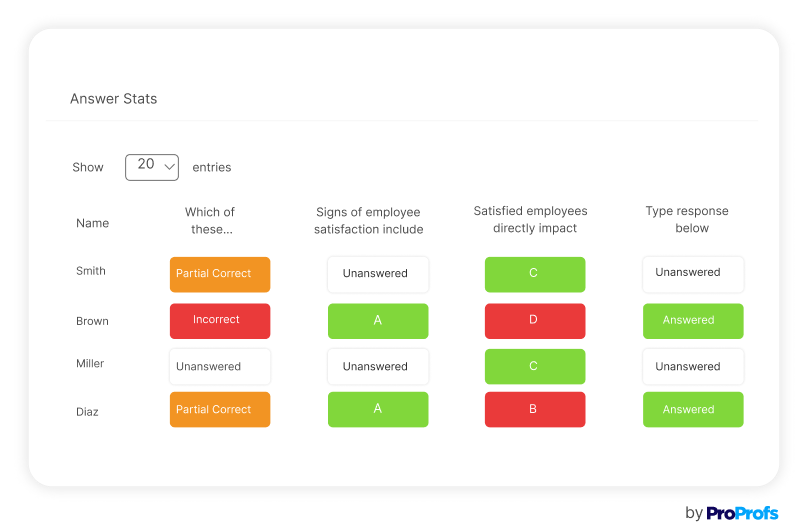
Review the information gathered from the assessment to identify patterns, strengths, and areas for improvement. This analysis provides insights into each student’s understanding and progress.
Step 5: Provide Feedback
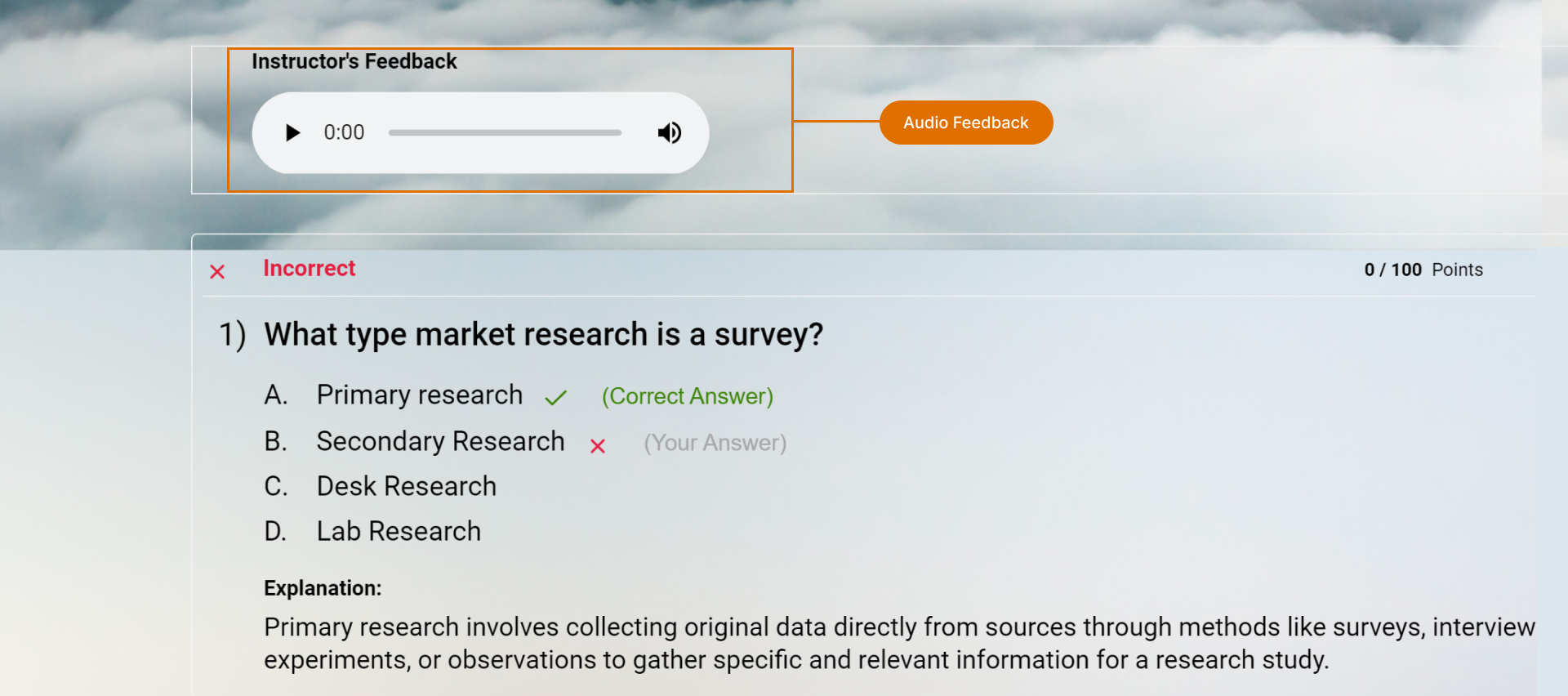
Offer timely and constructive feedback to students based on their performance. Effective feedback is specific, actionable, and focused on growth, helping students understand what they did well and where they can improve.
Step 6: Adjust Instruction
Based on the feedback and analysis, adapt your teaching strategies to address the identified learning gaps or challenges. This might involve revisiting specific topics, introducing new resources, or modifying learning activities to suit students’ needs better.
Step 7: Reflect on the Process
Finally, reflect on the effectiveness of the formative assessment process itself. Consider what worked well and what could be improved in future iterations. This reflection helps refine the assessment process, making it more effective over time.
Throughout this process, the emphasis is on fostering an environment of continuous learning and improvement. By actively engaging in each step, educators can create a responsive classroom atmosphere that supports every student’s growth and achievement.
Strategies for Effective Formative Assessments
To maximize the benefits of formative assessments, educators need to apply strategies that make the feedback loop as effective and seamless as possible. Here’s how to ensure formative assessments contribute positively to both teaching and learning:
- Embed Assessments in Everyday Learning
Make formative assessments a natural extension of classroom activities. After a science experiment, for instance, ask students to predict the outcome based on the theory they’ve learned. This not only assesses their understanding but also encourages critical thinking.
- Embrace Technology for Interactive Learning
Modern tools have revolutionized the way we assess and engage with students. ProProfs Quiz Maker, for example, offers an intuitive platform for creating quizzes that are both fun and educational.
You can create educational quizzes that provide instant feedback, helping students identify areas of strength and those needing improvement, all within an interactive format that captures their interest.
- Foster a Culture of Peer Feedback
Implement structured peer review sessions where students can offer constructive feedback on each other’s presentations or essays. This strategy not only diversifies the sources of feedback but also helps students develop a critical eye for their work and that of their peers.
- Encourage Reflective Practices
Guide students in reflecting on their learning experiences and outcomes. A reflective journal entry after completing a group project can provide insights into what they learned, the challenges they faced, and how they overcame them, fostering a deeper understanding of the learning process.
- Connect Learning to Real-World Applications
Design assessments that require students to apply classroom knowledge to solve real-world problems. For instance, in a geography class, students could analyze the impact of climate change on their local community, encouraging them to connect theory with practical, observable phenomena.
- Leverage Exit Tickets for Immediate Insights
At the end of a lesson, a simple question related to the day’s topic can serve as an exit ticket. This strategy offers quick insights into students’ understanding and retention, informing future instructional decisions.
What Are the Benefits of a Formative Assessment?
Formative assessments offer a wealth of benefits that significantly contribute to both teaching efficacy and student learning outcomes.
By integrating formative assessments into the educational process, educators and students can experience a more engaged, reflective, and practical learning journey. Here are some of the key benefits:
- Enhanced Learning and Understanding
Formative assessments help students consolidate their learning by actively engaging with the material. This continuous engagement promotes deeper understanding and retention of the content.
That’s exactly what Luc Viatour, a mathematics teacher and trainer, set out to achieve. Teaching over 1500 learners across different countries, he introduced formative quizzes using ProProfs to monitor comprehension and offer instant feedback. The flexibility of the platform helped his students learn at their own pace, while he gained clear visibility into their progress—without relying on high-stakes testing.
Watch: How Luc Viatour Transformed Education for 1500+ Daily Learners
- Immediate Feedback for Quick Adjustments
The real-time feedback provided through formative assessments allows students to identify their strengths and areas for improvement promptly. This immediacy enables quick corrective actions, fostering a more dynamic and responsive learning environment.
- Personalized Learning Experiences
Formative assessments identify individual learning needs, enabling educators to tailor their teaching strategies and resources. This personalization ensures that all students receive the support and challenge they need to progress.
- Increased Student Motivation and Engagement
Active involvement in the learning process increases students’ motivation and engagement. Formative assessments encourage students to take ownership of their learning, leading to higher levels of participation and interest.
- Development of Critical Thinking and Skills
Through activities like peer reviews and self-assessments, students develop essential skills, including critical thinking, self-reflection, and the ability to receive and apply feedback constructively.
- Support for a Growth Mindset
Formative assessments emphasize growth and improvement over grades, helping to cultivate a growth mindset among students. This perspective encourages learners to view challenges as opportunities to learn and grow rather than as failures.
- Improved Teacher-Student Relationships
The continuous interaction and feedback loop foster closer relationships between teachers and students. This rapport builds a supportive classroom atmosphere where students feel valued and understood.
- Data-Driven Instructional Decisions
Insights from formative assessments give educators a clear view of student understanding, enabling precise, data-driven adjustments to teaching. This targeted approach ensures lessons meet students’ exact needs, optimizing learning outcomes.
- Reduction of Test Anxiety
Integrating formative assessments throughout the learning journey shifts the focus from high-stakes evaluation to ongoing improvement, significantly easing test-related stress. This frequent, low-pressure feedback mechanism familiarizes students with the assessment process, building their confidence and diminishing anxiety over time.
- Preparation for Summative Assessments
Regular formative assessments prepare students for summative assessments by ensuring they understand the material and can apply their knowledge effectively. This preparation can lead to better performance on final exams and standardized tests.
Watch: How DMS Boosted Student Scores
How to Create a Formative Assessment Quiz
If you’re using an intuitive quiz tool, such as ProProfs Quiz Maker, the process for creating a quiz is quite straightforward. Here’s how to create a formative assessment quiz in five quick and easy steps:
Step 1: Click “Create a Quiz” on your dashboard.

Step 2: Pick a ready-to-use quiz, make a quiz with AI quiz maker, or build it from scratch.
Step 3: Add/edit the quiz title, description & cover image.
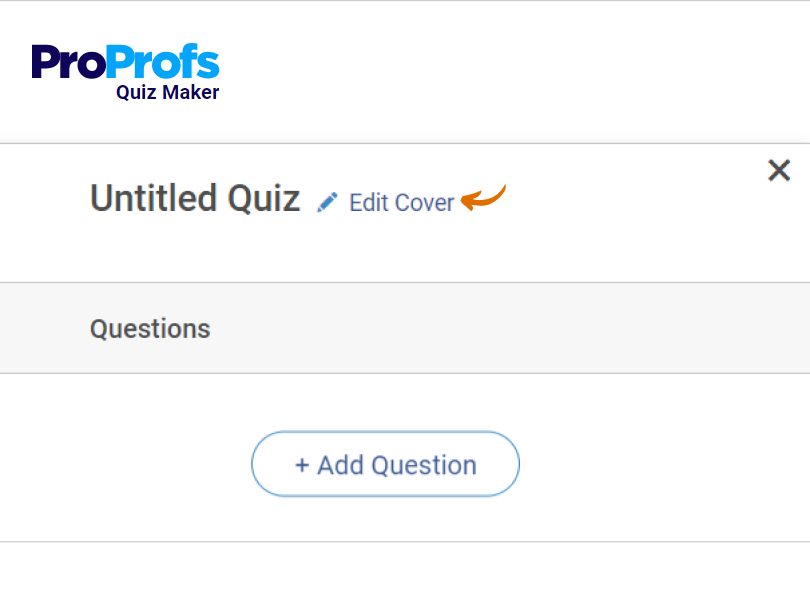
Step 4: Add/edit questions.
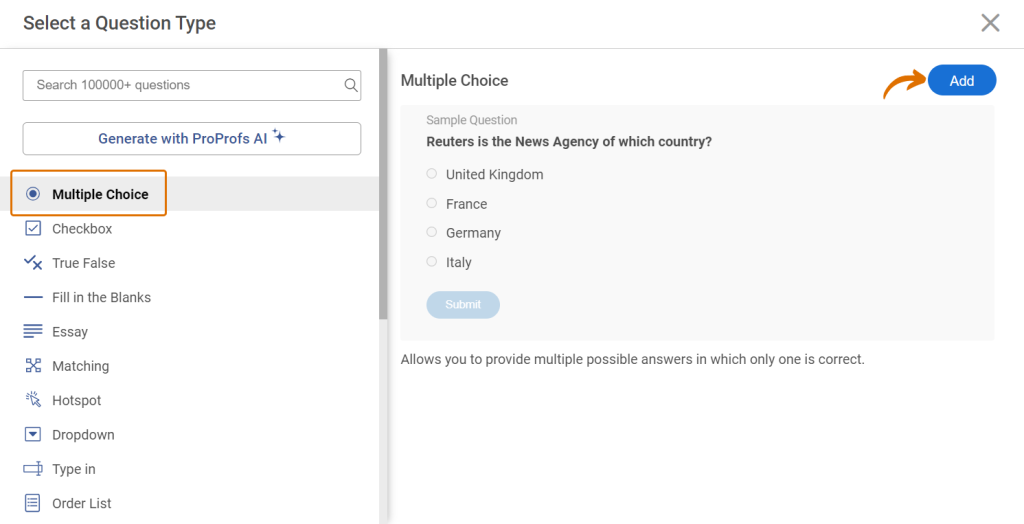
Employ a variety of question formats to explore diverse knowledge and skill areas, guaranteeing a thorough examination of the topic at hand.
ProProfs provides an array of question styles, including multiple-choice, fill-in-the-blanks, drag & drop, hotspot, and audio/video responses, facilitating a detailed assessment of learners’ comprehension.
Watch: 20+ Question Types for Online Learning & Assessment
You can add new questions by:
- importing them from 1,000,000+ ready-to-use questions
- using ProProfs AI to generate questions instantly
- creating them by yourself
You can add images, videos, audio clips, and docs to your quiz.
You can also automate the grading of your quizzes to save time and effort, which you can invest in providing individualized support to your learners.
Watch: How to Automate Quiz Scoring & Grading
You also have the option to offer explanations for answers immediately after a question is answered in the quiz. This instant feedback not only supports the learning process but also enables students to recognize areas requiring improvement.
Step 5: Configure settings.
You can implement several security and anti-cheating measures, including:
- Setting your quiz to be private and secured with a password
- Randomizing the sequence of questions and/or answer choices
- Developing a question pool and drawing a random selection of questions for each participant
- Overseeing the quiz through screen sharing, webcam, and microphone monitoring
- Preventing tab switching, printing, copying, downloading, and repeated attempts
Watch: How to Customize & Configure Your Quiz Settings
You can also change the quiz’s appearance by adjusting the background, colors, fonts, and button text. Plus, you can set the quiz to appear in the participant’s native language.
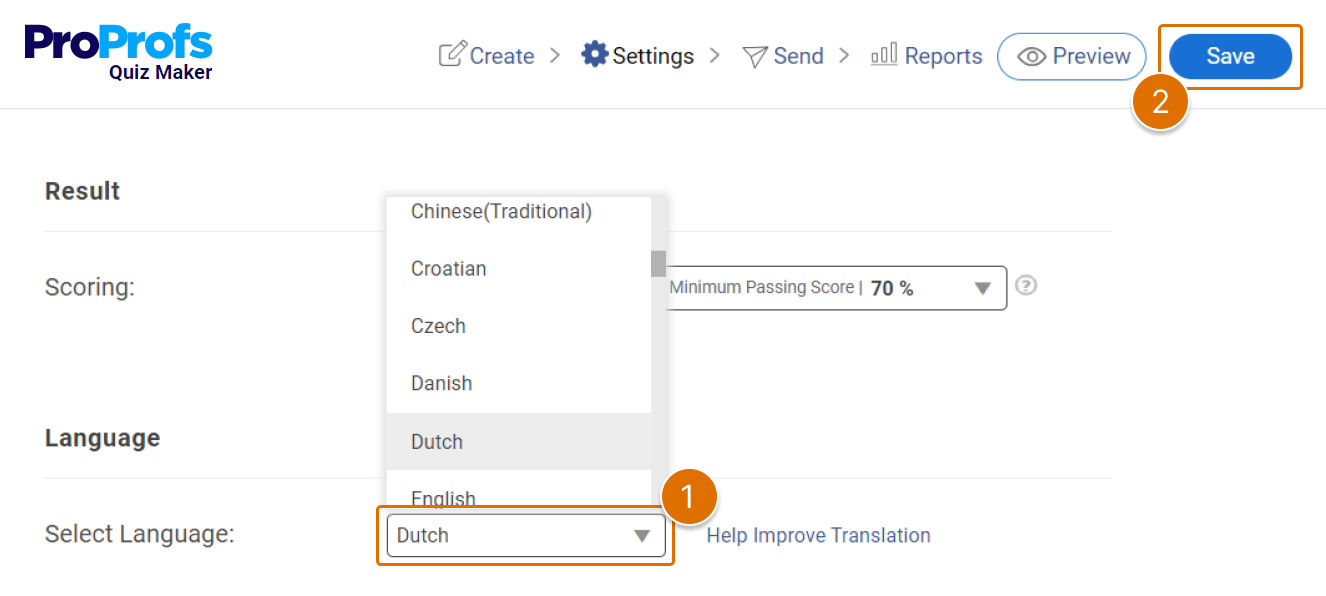
That’s it. Your formative assessment quiz is ready.
Analyzing the Results
After administering a formative assessment, ProProfs Quiz Maker delivers in-depth analytics that paints a complete picture of every student’s learning progress and overall class performance. This data is essential for modifying instructional strategies to better align with students’ learning needs.
Apply this insightful feedback to adjust your teaching plans, focusing on clarifying common misconceptions and bolstering areas where students show weaknesses.
FREE. All Features. FOREVER!
Try our Forever FREE account with all premium features!
Enhance Classroom Dynamics With Formative Assessments
Formative assessments aren’t just a teaching tool—they’re your chance to stay in tune with how learners are really progressing. They help you spot confusion early, give timely feedback, and adjust your approach while learning is still in motion.
With ProProfs Quiz Maker, it’s easy to create quick, engaging assessments that actually make a difference. Whether you’re running a classroom or managing training at scale, you’ll have the tools to personalize learning without extra complexity.
Want to test it out? Start with the forever free plan for short quizzes, or explore more with a free trial or a quick demo—whatever suits your style.
Frequently Asked Questions
What are formative and summative assessments?
Formative assessments are tools teachers use during the learning process to see how students are doing and to adjust their teaching methods. Summative assessments happen at the end of a learning period, like a final exam, to measure what students have learned overall.
Are quizzes summative or formative?
Quizzes can act as both formative and summative assessments. As formative assessments, quizzes are used throughout the learning process to guide both teaching and learning. As summative assessments, quizzes evaluate students’ final understanding at the end of a unit or semester.
Is a worksheet a formative assessment?
Worksheets can serve as formative assessments when used to monitor students’ understanding and inform future teaching strategies. They become practical tools for ongoing learning and adaptation in the classroom, emphasizing feedback over final grades.
 Tips
Tips
We’d love to hear your tips & suggestions on this article!
FREE. All Features. FOREVER!
Try our Forever FREE account with all premium features!
 We'd love your feedback!
We'd love your feedback! Thanks for your feedback!
Thanks for your feedback!


